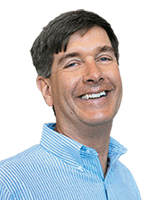Managing organic matter in greens
Clark Throssell, Ph.D., and Roch Gaussoin, Ph.D., discuss how golf course superintendents can manage organic matter in greens. Gaussoin is a turfgrass scientist at the University of Nebraska-Lincoln. He has conducted a wide range of research projects on organic matter accumulation in putting greens. You may reach Gaussoin at rgaussoin1@unl.edu for more information.

Clark Throssell
Q: Please clear up the confusion surrounding a putting green root zone built with 80-percent sand and 20-percent peat by volume, yet when tested has only about 0.5-percent to 1-percent soil organic matter.
We measure the sand and peat used to construct a root zone by volume, usually using the bucket of a loader. Soil organic matter is most commonly determined using a laboratory procedure called “weight loss on ignition.” The results from this procedure are expressed as a percent by weight.
Based on many measurements, an 80-percent sand and 20-percent peat root-zone mixture by volume has an organic matter content of 0.5 percent to 1 percent by weight.
Q: Where in the putting green profile should a superintendent be concerned about the amount of organic matter present?
It’s all about putting green surface performance. Each superintendent must determine the desired surface performance of his or her greens by focusing on the characteristics of the mat layer. The mat layer is that zone just below the green — living turf that is composed of a mixture of organic matter and sand.
Firm and fast are at one end of the spectrum, and soft and slightly slower are at the other end of the spectrum. It’s up to superintendents to determine where on this spectrum they want the greens to perform. It’s essential that superintendents develop and stick to a management plan that allows them to reach their goal.
Q: Where does the organic matter in a putting green come from, and what influence does a superintendent have on how much organic matter is produced?
Turfgrass plants produce organic matter in the form of dead leaves, shoots, crowns and rhizomes, and stolons if the desired turf produces these structures. A healthy, actively growing stand of turf will produce organic matter naturally. And this is a good thing. A green with low organic matter often is not functioning as well as it should.
Excessive inputs of nitrogen and irrigation and a lack of golfer traffic often are associated with greens that have a higher-than-desired organic matter content.
Q: Is there a single, specific target for organic matter percentage in the surface layer that a superintendent should try to achieve?
No. There is no magic number for organic matter percentage to use as a guide. The desired amount of organic matter in the mat layer is golf-course specific, and superintendents know what works best at their golf courses.
Organic matter functions as a sponge. Too much organic matter at the surface holds excessive water, creating unhealthy conditions for turfgrass growth and less-than-desired putting green playability.
Q: Describe the sampling procedures needed to yield a valid determination of soil organic matter.
Unfortunately, there are no accepted standardized sampling procedures for determining organic matter in a putting green. That said, in whatever sampling procedures you use, be consistent in all aspects. For instance, use the same lab every time to determine organic matter and make sure the lab uses the same procedure every time to determine soil organic matter. Sample to the same depth, take the same number of subsamples from each green before combining them and sample at the same week and month each year (organic matter content varies by month of the growing season). Be consistent about leaving or trimming off the green living tissue. There is not complete agreement about whether the green living tissue should be submitted as part of a sample.
Q: Anything else you would like to add?
In many instances, a solid tine will produce results as good as a hollow tine when trying to manage organic matter.
I would like to thank the USGA, EIFG, Nebraska Turfgrass Association, Nebraska GCSA, South Dakota GCSA and the Peak and Prairies GCSA for their generous financial support of my organic matter research.










